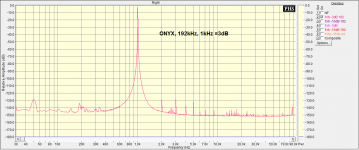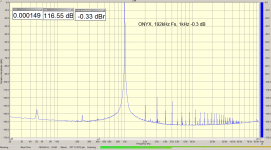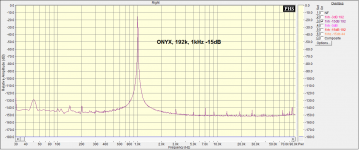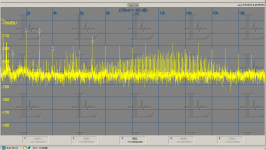JensH, good work and nice design!
I have the similar project, just with AK5394 + AK4490, with XMOS USB interface.
But the results are not so good as your (THD and SNR) and I'm still working on it.
BTW, can you post the measurements with 0dBFS and -1-2dBFS at ADC input?
Very interesting to know what 5497 do.
Did you try 5397's Mono mode?
Thank you.
I have the similar project, just with AK5394 + AK4490, with XMOS USB interface.
But the results are not so good as your (THD and SNR) and I'm still working on it.
BTW, can you post the measurements with 0dBFS and -1-2dBFS at ADC input?
Very interesting to know what 5497 do.
Did you try 5397's Mono mode?
Thank you.
@ Demian,
I don't have a real spectrum analyzer, so I have tried to measure the noise spectrum with my oscilloscope. See the attached document.
At least with this method I don't see the same level of noise as you have measured on the AK4399.
@Alex,
I have measured the distortion of the input section (amp+ADC) at different levels. All at 1 kHz. I used the generator at levels below -10dBFS. Yesterday I measured the distortion of the generator at 1kHz/-10dBFS with a Panasonic VP-7722A. The result was -122dB, so I think the generator is OK for this test.
Some of the results from the test:
Level (dBFS) Distortion
0.03 -94.3
-1 -100.6
-2 -102.8
-5 -107
-10 -111.8
-15 -120.4
For the last two measurements I used an FFT of 512k to be lower the noise floor, which would otherwise start to add to the distortion level. The other measurements were done with a 128k FFT.
The first measurement is clearly very close to the clipping point although the overflow output of the ADC did not indicate overflow.
I have not tried the AK5397 in the mono mode.
I don't have a real spectrum analyzer, so I have tried to measure the noise spectrum with my oscilloscope. See the attached document.
At least with this method I don't see the same level of noise as you have measured on the AK4399.
@Alex,
I have measured the distortion of the input section (amp+ADC) at different levels. All at 1 kHz. I used the generator at levels below -10dBFS. Yesterday I measured the distortion of the generator at 1kHz/-10dBFS with a Panasonic VP-7722A. The result was -122dB, so I think the generator is OK for this test.
Some of the results from the test:
Level (dBFS) Distortion
0.03 -94.3
-1 -100.6
-2 -102.8
-5 -107
-10 -111.8
-15 -120.4
For the last two measurements I used an FFT of 512k to be lower the noise floor, which would otherwise start to add to the distortion level. The other measurements were done with a 128k FFT.
The first measurement is clearly very close to the clipping point although the overflow output of the ADC did not indicate overflow.
I have not tried the AK5397 in the mono mode.
Attachments
Jens- Was that at the chip or the output? I was measuring at the chip.
AKM has said the AK5397 is not as low distortion as the AK5394A when pressed but I'm sure there are some techniques to get the distortion lower to be discovered. The AK5394A performance is quite exceptional.
AKM has said the AK5397 is not as low distortion as the AK5394A when pressed but I'm sure there are some techniques to get the distortion lower to be discovered. The AK5394A performance is quite exceptional.
Jens- Was that at the chip or the output? I was measuring at the chip.
AKM has said the AK5397 is not as low distortion as the AK5394A when pressed but I'm sure there are some techniques to get the distortion lower to be discovered. The AK5394A performance is quite exceptional.
That is quite disappointing, all this time for a new IC and it's not really an improvement in all areas.
These chips are really at the edge of what is possible with the physics. The new chip is supposed to have better SNR (it seems to) and the market is not as interested in lower distortion as SNR. Adding sample rates up to 786 and the internal DSP to bond two channels into one to get an additional 3 dB is a value. Its possible that there will be a distortion improvement as well.
Keep in mind that this is a tiny market and AKM may never get the investment back. TI will not make any new chips with better than 100 dB SNR (no ROI) but will get you more 100 dB ADC's per chip for very little cost. Cirrus's top chip is 10 years old as well. Wolfson got absorbed by Cirrus so fewer options even.
Keep in mind that this is a tiny market and AKM may never get the investment back. TI will not make any new chips with better than 100 dB SNR (no ROI) but will get you more 100 dB ADC's per chip for very little cost. Cirrus's top chip is 10 years old as well. Wolfson got absorbed by Cirrus so fewer options even.
Yes. The measurements "Before post-DAC filter" were at the DAC output. There are also some "After post-DAC filter" measurements.Jens- Was that at the chip or the output? I was measuring at the chip.
Unfortunately the spectrum curves have a rather bright color, so they are not the easiest to read. On the screen, with a black background, they work much better.
I will try to modify the circuit around the ADC inputs to see if it is possible to improve the THD. In the data sheet there are a couple of DAC driver circuits. The one with the LME49990 (which I have implemented) seems to have higher THD than the circuit with the LME49710. Apart from the change of op-amp there is a difference in capacitor configuration on the ADC input. So I need to do a bit of experimenting here.
It is a pity with the relatively high THD, since the noise performance is very good. I haven't seen any discrete noise frequencies popping up, except for something just below 48 kHz that I saw in some of the initial measurements, but I don't think this is related to the ADC chip. It is not exactly 48 kHz and it seems to be "something" in my test environment.
Worst case I may have to go back to the AK5394A to get a good THD performance.
Yes, it is a tiny market. It is good to see that AKM is still actively developing new devices for this market.
One question Jens:
Why didn't you use the ES9018M2 / ES9102A ?
On paper they seems to be the best audio parts available for measurement applications, although just like AKM they only really spec up to 20 Khz.... I would love see noise and thd curves all the way to nyquest for all sample rates.
The ESS parts are more expensive, but pricing of the ADC / DAC chips shouldn't ruin the financials of the project....
Why didn't you use the ES9018M2 / ES9102A ?
On paper they seems to be the best audio parts available for measurement applications, although just like AKM they only really spec up to 20 Khz.... I would love see noise and thd curves all the way to nyquest for all sample rates.
The ESS parts are more expensive, but pricing of the ADC / DAC chips shouldn't ruin the financials of the project....
On paper they seems to be the best audio parts available for measurement applications, although just like AKM they only really spec up to 20 Khz.... I would love see noise and thd curves all the way to nyquest for all sample rates.
The ESS parts are more expensive, but pricing of the ADC / DAC chips shouldn't ruin the financials of the project....
One may reason is the interface part to and from the PC:
1. The miniDSP USBStreamer is used and Jens did for this HW a special interface isolation board with an own master clock. Currently the master clock do not get at the required ESS speed.
2. Using the USBStreamer with the 8 I/O channels a channel bundling could be do be HW and the required host SW (as I did already see measurements for 2x,4x stereo or 8x base sample rates).
3. One limitation is currently (as on the DAM) there is no modular (system) board design, where your exchange only the input or output module (attenuation, gain, ADC or DAC) for your custom needs or supplier HW chip improving
4. Currently I do not see even for ESS how they perform up to 384 kHz as for AKM (would go 768 kHz)
I love to have a HW like this (as I loved to build since a decade) ... it's the base part for any serious DAC development and not stopping to measure at 20kHz measurement (see real noise figures from the DAC
Cheers
Hp
When I measured the ESS ADC it was not performing anywhere near this level. I tried all the tricks from ESS but no success. I have the plots somewhere but there were not good enough save as images.
The ESS DAC measures well but is not a whole lot better. The picture below is using a Shibasoku 725d analyzer so the ADC side is not a limitation.
The need for different clocks, the difficulty with the sample rate conversion etc all make it much harder to use for the same task.
The ESS DAC measures well but is not a whole lot better. The picture below is using a Shibasoku 725d analyzer so the ADC side is not a limitation.
The need for different clocks, the difficulty with the sample rate conversion etc all make it much harder to use for the same task.
Attachments
@soekris:
I did of course consider using the ESS parts. On paper they look very interesting. But there is not very much solid material with measurement data available, as far as I know. So the real performance is unknown. And I have seen descriptions of various noise phenomena, where the noise seems to change in character over time.
And what is the noise performance beyond 20 kHz?
The sample rate conversion also makes it a bit difficult to know exactly what is going on.
And yes, the price does not exactly make them attractive to "play with".
And I prefer converters, which don't need SW configuration.
I think that there are too many open questions to make it an obvious choice. And I don't really have access to a support line from ESS at the moment.
But who knows, maybe one day I will try the ESS converters for this design?
@HpW
1. I could easily provide clock frequencies of 45.1584MHz and 49.152MHz (or higher) instead of 22.5792MHz and 24.576MHz if needed for the converters. The USBStreamer interface would still work in this case.
4. 384kHz might be OK, if the frequency response is reasonably flat in this mode.
Jens
edit: I just saw Demians post after I submitted mine. It supports my view of the ESS converters. I don't know the exact origin of the noise in the measurement, but it looks fairly messy.
I did of course consider using the ESS parts. On paper they look very interesting. But there is not very much solid material with measurement data available, as far as I know. So the real performance is unknown. And I have seen descriptions of various noise phenomena, where the noise seems to change in character over time.
And what is the noise performance beyond 20 kHz?
The sample rate conversion also makes it a bit difficult to know exactly what is going on.
And yes, the price does not exactly make them attractive to "play with".
And I prefer converters, which don't need SW configuration.
I think that there are too many open questions to make it an obvious choice. And I don't really have access to a support line from ESS at the moment.
But who knows, maybe one day I will try the ESS converters for this design?
@HpW
1. I could easily provide clock frequencies of 45.1584MHz and 49.152MHz (or higher) instead of 22.5792MHz and 24.576MHz if needed for the converters. The USBStreamer interface would still work in this case.
4. 384kHz might be OK, if the frequency response is reasonably flat in this mode.
Jens
edit: I just saw Demians post after I submitted mine. It supports my view of the ESS converters. I don't know the exact origin of the noise in the measurement, but it looks fairly messy.
Last edited:
One may reason is the interface part to and from the PC:
1. The miniDSP USBStreamer is used and Jens did for this HW a special interface isolation board with an own master clock. Currently the master clock do not get at the required ESS speed.
2. Using the USBStreamer with the 8 I/O channels a channel bundling could be do be HW and the required host SW (as I did already see measurements for 2x,4x stereo or 8x base sample rates).
3. One limitation is currently (as on the DAM) there is no modular (system) board design, where your exchange only the input or output module (attenuation, gain, ADC or DAC) for your custom needs or supplier HW chip improving
4. Currently I do not see even for ESS how they perform up to 384 kHz as for AKM (would go 768 kHz)
I love to have a HW like this (as I loved to build since a decade) ... it's the base part for any serious DAC development and not stopping to measure at 20kHz measurement (see real noise figures from the DACgiven form Demian)
Cheers
Hp
I see a need for a low cost audio analyzer, a real useful one with attenuators, balanced i/o and digital i/o, not just an audio interface like the EMU 0404 or a limited one like the QA400.
Therefore parts should be chosen to be the best for the job, not for convenience.... So I just want to know if the AKM parts have been determined to be the best for the job, the ESS parts seems to have better specs....
As I see it the AKM parts also have a problem with 384K / 768K sample rates as the filters there start early and are soft, fine for music but not so fine for measuring applications.
And as I said, the ESS parts look best on paper, but real life measurement would be great. If they have been done I haven't seen them.... All D-S ADC/DACs have increased noise over 20 Khz due to the noise shaping, but none of the manufacturers show the actual curves. ESS should in principle have an advantage due to higher clock....
The ADC part should really be done with multiple interleaved industrial SAR ADC's like the LTC2378-20, those can do -120db thd and very high bandwidth, but then you have the interface issue....
If I just had the time....
@soekris:
I did of course consider using the ESS parts. On paper they look very interesting. But there is not very much solid material with measurement data available, as far as I know. So the real performance is unknown. And I have seen descriptions of various noise phenomena, where the noise seems to change in character over time.
And what is the noise performance beyond 20 kHz?
The sample rate conversion also makes it a bit difficult to know exactly what is going on.
And yes, the price does not exactly make them attractive to "play with".
And I prefer converters, which don't need SW configuration.
I think that there are too many open questions to make it an obvious choice. And I don't really have access to a support line from ESS at the moment.
But who knows, maybe one day I will try the ESS converters for this design?
Jens
Oops, your posting just crossed mine....
One note, the sample rate conversion in the ESS parts can and should be bypassed.
The really smart thing would be that we put our efforts together and make the ultimate audio analyzer, I can easily see it divided in:
Analog input board, galvanic isolated
Analog output board, galvanic isolated
Digital Input/Output board
USB interface, processor for management
Software
Later on:
Analog high speed input board using fast SAR ADC chips
Ethernet / AES67 interface board, to use that high speed
Target is of course to match the AP555
Analog input board, galvanic isolated
Analog output board, galvanic isolated
Digital Input/Output board
USB interface, processor for management
Software
Later on:
Analog high speed input board using fast SAR ADC chips
Ethernet / AES67 interface board, to use that high speed
Target is of course to match the AP555
I wanted to use standard off the shelf audio converters to build an Audio Analyzer with good performance. I think that the AKM parts are very good for the job. Perhaps even the best? But it is still an open question whether the AK5397 offers a real benefit compared to AK5394A. The dynamic range is definitely better, but if the distortion is much higher, the AK5394A might be better. This is still TBD.
I agree that there is a problem with the 384k/768k sample rates. The frequency responses at those sample rates are far from ideal. It might be useful to check what is present above 100kHz, but it probably won't be a precision measurement.
Using SAR ADC's would require a completely different level of effort. And at the moment this is just a hobby project. So I have no immediate plans to beat the AP555
I agree that there is a problem with the 384k/768k sample rates. The frequency responses at those sample rates are far from ideal. It might be useful to check what is present above 100kHz, but it probably won't be a precision measurement.
Using SAR ADC's would require a completely different level of effort. And at the moment this is just a hobby project. So I have no immediate plans to beat the AP555
When I measured the ESS ADC it was not performing anywhere near this level. I tried all the tricks from ESS but no success. I have the plots somewhere but there were not good enough save as images.
The ESS DAC measures well but is not a whole lot better. The picture below is using a Shibasoku 725d analyzer so the ADC side is not a limitation.
The need for different clocks, the difficulty with the sample rate conversion etc all make it much harder to use for the same task.
Your posting also crossed mine....
Shouldn't you assume that ESS can meet the specs ?? The output buffers are pretty critical to meeting specs, so the fft plot itself isn't that useful without buffer schematics....
I wanted to use standard off the shelf audio converters to build an Audio Analyzer with good performance. I think that the AKM parts are very good for the job. Perhaps even the best? But it is still an open question whether the AK5397 offers a real benefit compared to AK5394A. The dynamic range is definitely better, but if the distortion is much higher, the AK5394A might be better. This is still TBD.
I agree that there is a problem with the 384k/768k sample rates. The frequency responses at those sample rates are far from ideal. It might be useful to check what is present above 100kHz, but it probably won't be a precision measurement.
Using SAR ADC's would require a completely different level of effort. And at the moment this is just a hobby project. So I have no immediate plans to beat the AP555
As I said, we should work together, I'll be happy to do a SAR ADC module if the audio analyzer were modular, have other plans for them anyway, if I didn't have to do everything else.
But it might not be feasible at point you are now in your project.
Those distortion levels are really impressive. Especially considering that it is at 192 kHz sample rate. E.g. the distortion at 0.3dB is lower than what I get with the AK5397.
How do you drive the ADC inputs? Any special design features?
You will not beleive - just OPA1632D!
With G=1 and AC-coupled inputs (yes, input electrolytic capacitor is less worse then OPA1632 with 0v DC at input and 2.3V output offset!)
Unfortunately, ~ a year I did not work on this project, because of another ones, but there is in my plans to return.
What I plan: - to try 5394 overclock (to reach 384kHz) and adjustable rejector (to eliminate the fundamental frequency), together with Low or Band Pass for output part (to decrease DAC's THD).
- Home
- Design & Build
- Equipment & Tools
- DIY Audio Analyzer with AK5397/AK5394A and AK4490



